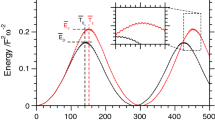Abstract
The three dominant mechanisms giving major contributions to vibrational relaxation in molecular systems are (a) pure dephasing, (b) depopulation (or energy relaxation), and (c) resonant transfer. Here (c) is not considered but the effects due to thesimultaneous occurrence of (a) and (b) are treated within a stochastic model. In dealing with (a), the vibrational frequency is assumed to undergo random uncorrelated ‘jump’, due to fluctuations in the environment of the active molecule between a continuous set of values. The ensuing results are somewhat different from those of the commonly used Kubo model of vibrational dephasing, especially at long times and appear to be better suited in interpreting certain experimental data. The model is next extended to include the simultaneous occurrence of (b). The calculation leads to two important conclusions: (i) the lineshape is not just the convolution of those due to (a) and (b), and (ii) the lineshape is asymmetric, if the intermolecular interactions are not isotropic.
Similar content being viewed by others
References
Bailey R T 1974Molecular spectroscopy, Vol. 2 (The Chemical Society of London)
Bartoli F J and Litovitz T A 1972J. Chem. Phys. 56 404, 413
Blume M 1968Phys. Rev. 17 351
Bratos S, Guissani Y and Leicknam J C 1978Intermolecular spectroscopy and dynamical properties of dense systems (ed.) J Van Kranendonk (Amsterdam: North Holland)
Campbell J H, Fischer J F and Jonas J 1974J. Chem. Phys. 61 346
Dattagupta S 1977Pramana 9 203
Dattagupta S and Sood A K 1979Pramana 13 423
Dattagupta S 1981Hyperfine interactions (to be published)
Eagles T E and McClung R E D 1973Chem. Phys. Lett. 22 414
Fisher S F and Laubereau A 1975Chem. Phys. Lett. 35 6
Gordon R G 1966J. Chem. Phys. 44 1830
Harris C B, Shelby R M and Cornelius P A 1977Phys. Rev. Lett. 38 1415
Harris C B, Shelby R M and Cornelius P A 1978Chem. Phys. Lett. 57 8
Herzfeld K F and Litovitz T A 1959Absorption and dispersion of ultrasonic waves (New York: Academic Press)
Janik J A and Kowalska 1965Thermal neutron scattering, (ed.) P A Egelstaff, Chapter 9 (New York: Academic Press)
Kubo R 1962Fluctuations, relaxation, and resonance in magnetic systems, (ed.) D. ter Haar (Edinburgh: Oliver & Boyd)
Kubo R 1969Adv. Chem. Phys. Vol. 15, (ed.) I Prigogine and S A Rice (New York: John Wiley)
Laubereau A and Kaiser W 1978Rev. Mod. Phys. 50 607
Lynden-Bell R M 1977Mol. Phys. 33 907
Oxtoby D W 1979Adv. Chem. Phys. Vol. 40 (ed.) I Prigogine and S A Rice (New York: John Wiley)
Oxtoby D W, Lavesque D and Weis J J 1978J. Chem. Phys. 68 5528
Oxtoby D W and Rice S A 1976Chem. Phys. Lett. 42 1
Purniah B 1981 (unpublished)
Rautian S G and Sobel’man I I 1967Sov. Phys. Usp. 9 701
Rothschild W G 1976J. Chem. Phys. 65 455
Schroeder J, Schiemann V H, Sharko P T and Jonas J 1977aJ. Chem. Phys. 66 3215
Schroeder J, Schiemann V H and Jonas J 1977bMol. Phys. 34 1501
Shelby R M, Harris C B and Cornelius P A 1979J. Chem. Phys. 70 34
Wertheimer R K 1978Mol. Phys. 35 257
Author information
Authors and Affiliations
Rights and permissions
About this article
Cite this article
Sood, A.K., Dattagupta, S. Model for vibrational relaxation: Pure-dephasing and depopulation. Pramana - J. Phys. 17, 315–326 (1981). https://doi.org/10.1007/BF02850438
Received:
Issue Date:
DOI: https://doi.org/10.1007/BF02850438




